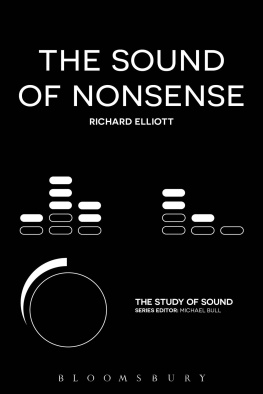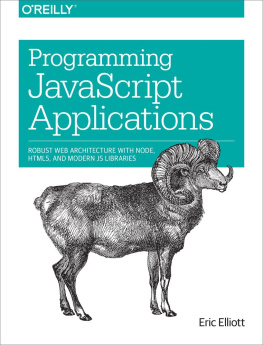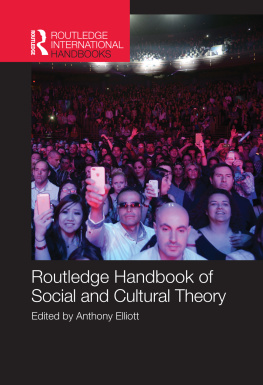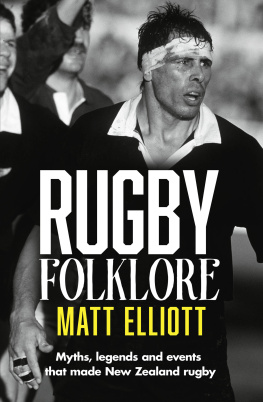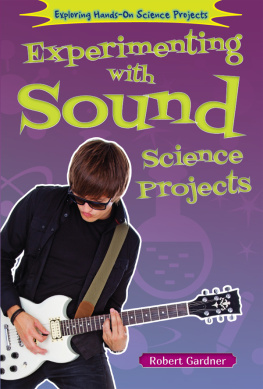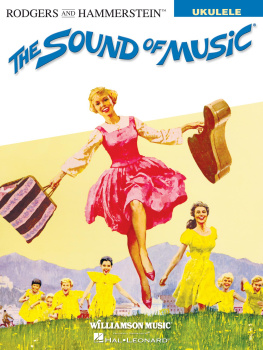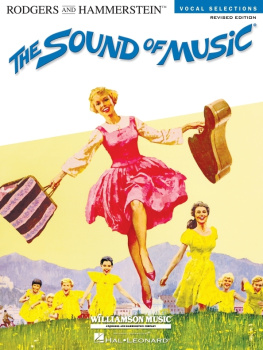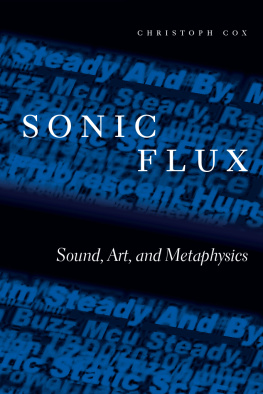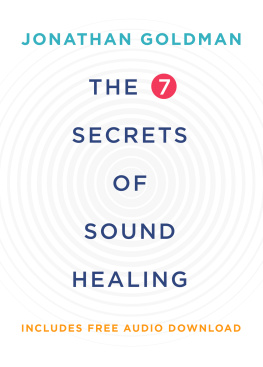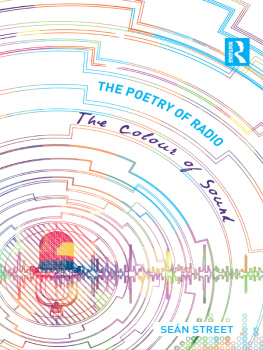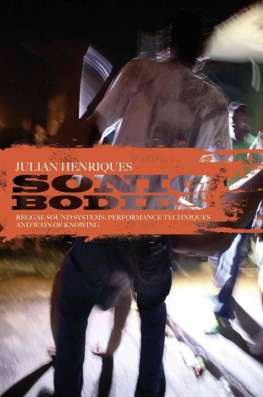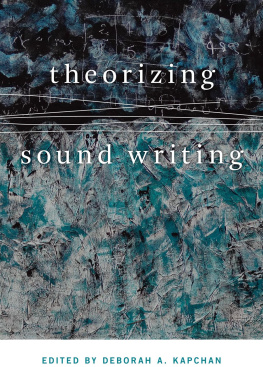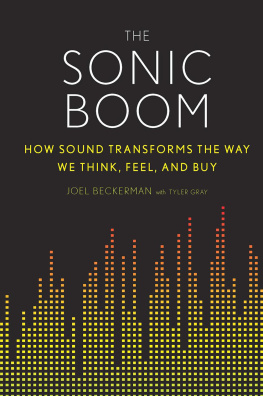The Sound of Nonsense
The Study of Sound
Editor: Michael Bull
Each book in The Study of Sound offers a concise look at a single concept within the field of sound studies. With an emphasis on the interdisciplinary nature of the topics at hand, the series explores a range of core issues, debates, and objects within sound studies from a variety of perspectives and within a multitude of contexts.
Editorial Board:
Carolyn Birdsall, Assistant Professor of Television and Cross-Media Culture, University of Amsterdam, The Netherlands
Martin Daughtry, Assistant Professor of Music, Arts and Humanities, NYU, USA
Michael Heller, Associate Professor, Department of Music, University of Pittsburgh, USA
Brian Kane, Associate Professor, Department of Music, Yale University, USA
Marie Thompson, Lecturer, School of Film and Media, University of Lincoln, UK
James Mansell, Assistant Professor of Cultural Studies, Department of Culture, Film and Media, University of Nottingham, UK
Forthcoming Titles:
Sirens by Michael Bull
Sonic Intimacy by Malcolm James
Humming by Suk-Jun Kim
Sonic Fiction by Holger Schulze
The Sound of Nonsense
Richard Elliott
Bloomsbury Academic
An imprint of Bloomsbury Publishing Plc

CONTENTS
Watch the sense and the sounds will take care of themselves, so says the Duchess in Alices Adventures in Wonderland . This book responds to that reliance by highlighting the importance of sound in understanding the nonsense of writers such as Carroll and Edward Lear, as well as James Joyce, before connecting this noisy writing to works which engage more directly with sound, including sound poetry, experimental music and pop. By emphasizing sonic factors, I try to amplify the connections between a wide range of artistic examples and to build a case for the importance of sound in creating, maintaining and disrupting meaning.
Nonsense literature, particularly that associated with the English tradition made famous by Carroll and Lear, has generated a rich and varied body of study in a variety of disciplines, including literature, linguistics, art history, philosophy and psychology. Much of this exegesis has focused on questions of meaning and the logic of sense or on questions of normality and abnormality. Invariably focused on words and sentences as they appear on the page, few studies of nonsense take sound as their primary analytical perspective. I take this gap as my starting point and, while engaging with many of the other things that have been said about my chosen examples, I hinge my study on the sonic dimensions of nonsense. The first chapter offers an overview of some of the ways in which nonsense has been approached, noting the difficulties in defining terms and agreeing on boundaries. By way of my own definitions, I suggest types of nonsense that bind the diverse examples to be found through the rest of the book. I also start to offer observations on the role of sound in creating, maintaining and disrupting sense. The second chapter is focused on the resonance of the page and, in addition to nonsense literature, includes discussion of modernist literature. More work has been done in recent years on the role of sound in modernist writing particularly James Joyce and my aim here is to highlight sounds which are pertinent to a discussion of nonsense and to set up connections with music, for example by considering how the work of writers such as Carroll and Joyce has been auralized or musicalized. Having established the importance of sound on the written page, the book moves to work that more directly challenged the written dimension of literature by engaging with sound as a primary text; examples include artists and theorists associated with a variety of European art movements (futurism, Dada, surrealism), sound poets such as Hugo Ball, Henri Chopin and Bob Cobbing, and the audiovisual cut-up experiments of Brion Gysin and William Burroughs. Here Im interested in sonic challenges, be they chopped audio or sonic palimpsests, and the efforts required to get at meaning.
One of the aims of the book is to show connections between modernist, avant-garde or experimental artists and those more associated with popular culture, so, in keeping with a starting point of Carroll and Lear, the project also investigates the importance of nonsense sounds in popular music. Chapter 4 the longest is devoted to popular music and the importance of nonsense in popular song, taking in scat singing, vocalese, doo-wop, early rock n roll, yodelling, hip-hop, singer-songwriters and artists who have created their own languages in which to sing. The relationships between words, sense and music are important here. One suggestion is that the shift from words to music is from a linguistic perspective often accompanied by a shift to nonsense, but that this linguistic nonsense becomes subject to another kind of musicalized sense-making. The process can also be witnessed in reverse; vocal sounds used to emulate musical instruments (e.g. in scat, doo-wop or other mouth music) can be heard as proto-words and the point at which they are heard as such is what I call the nonsense moment . Nonsense functions in these instances as the overlapping territory between non-semantic vocables and clearly understood, meaningful words.
In tracing this trajectory, I am interested in how written, spoken and sung linguistic elements predominantly words, parts of words and elements of phrases create nonsense moments that rely on sound in one form or another. To make the kind of connections I am making between written and sonic texts requires an acceptance of the interrelationships between what Don Ihde calls the word as soundful and sounds as meaningful:
The philosopher, concerned with comprehensiveness, must eventually call for attention to the word as soundful . On the other side, the sciences that attend to the soundful, from phonetics to acoustics, do so as if the sound were bare and empty of significance in a physics of the soundful. And the philosopher, concerned with the roots of reflection in human experience, must eventually also listen to the sounds as meaningful .
Like Ihde, I am interested in sound as it is experienced phenomenologically, although I mix this approach with awareness of intertextuality and intermediality. For me, the knowledge of a texts precursors and this includes ones lack of, or partial, knowledge of them is part of the phenomena available to the perceiving subject. This awareness, which I see as a grasping after meaning by a sometimes bewildered subject, is also what makes up the nonsense moment. This is the moment in perception when one is beyond, between or ahead of the moment of ascertaining sense. It is a glitch moment, a temporary period of blurring, the point in the process of code-switching where the codes are muddled.
Hopefully, the examples provided throughout the book will help clarify what I mean by this. I flag it up here, however, to anticipate some potential issues that readers may have regarding my definitions of nonsense, the ambitious scope of this short book and the connections I am making between my various examples. I approach the issue of definitions and typologies of nonsense more fully in the next chapter. For now, its important to note that this is a book about nonsense, not solely about nonsense literature, though nonsense literature is a recurring presence. When it comes to nonsense and music, some may well take exception to scat, doo-wop or vocalese being referred to as nonsense because these vocal techniques have been categorized for musicology as musical, not verbal practices. My response here is to challenge such absolutist definitions of these musical processes and to ask instead why so many other people before me have made similar connections to mine. Were such listeners wrong to do so? There is no hard and fast boundary between nonsense syllables used for musical effect and those same syllables used as words in a lyric. When Gene Vincent sings Be-bop-a-lula, shes my baby, or when the Edsels sing I got a girl named Rama Lama, Rama Lama Ding Dong, how can we know if they are imitating instruments or referring to nicknames? The syntax of such utterances hangs in the balance.

